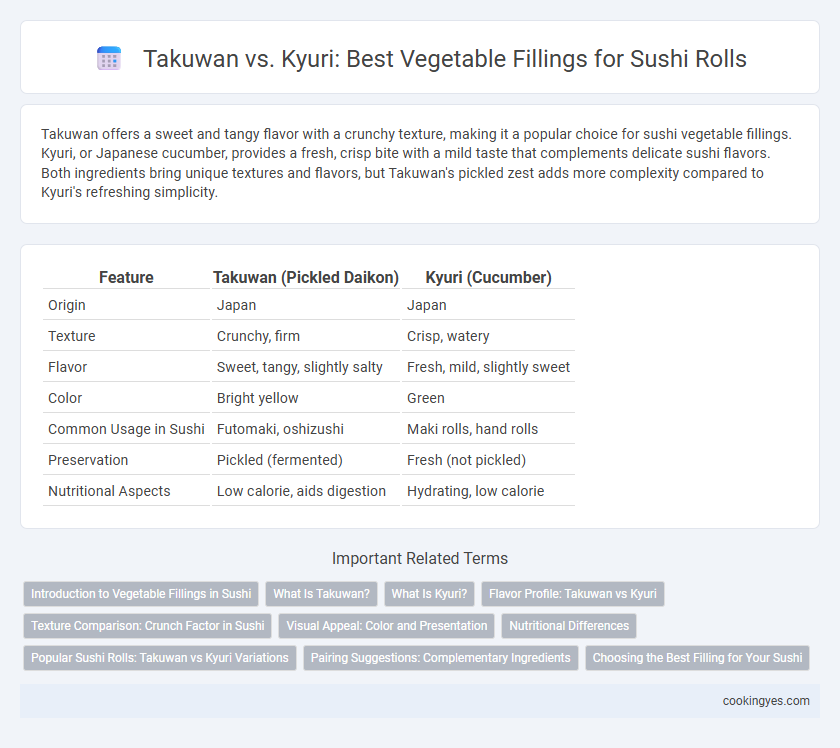Takuwan offers a sweet and tangy flavor with a crunchy texture, making it a popular choice for sushi vegetable fillings. Kyuri, or Japanese cucumber, provides a fresh, crisp bite with a mild taste that complements delicate sushi flavors. Both ingredients bring unique textures and flavors, but Takuwan's pickled zest adds more complexity compared to Kyuri's refreshing simplicity.
Table of Comparison
| Feature | Takuwan (Pickled Daikon) | Kyuri (Cucumber) |
|---|---|---|
| Origin | Japan | Japan |
| Texture | Crunchy, firm | Crisp, watery |
| Flavor | Sweet, tangy, slightly salty | Fresh, mild, slightly sweet |
| Color | Bright yellow | Green |
| Common Usage in Sushi | Futomaki, oshizushi | Maki rolls, hand rolls |
| Preservation | Pickled (fermented) | Fresh (not pickled) |
| Nutritional Aspects | Low calorie, aids digestion | Hydrating, low calorie |
Introduction to Vegetable Fillings in Sushi
Takuwan and kyuri serve as popular vegetable fillings in sushi, offering distinct flavors and textures that enhance the overall experience. Takuwan, made from pickled daikon radish, provides a sweet and tangy crunch, while kyuri, or cucumber, adds a refreshing crispness and mild flavor. Incorporating these fillings introduces a balance of taste and texture that complements rice and seafood in sushi rolls, making them essential choices for vegetable-based varieties.
What Is Takuwan?
Takuwan is a pickled daikon radish commonly used in sushi rolls, known for its vibrant yellow color and sweet, tangy flavor that adds a crunchy texture. Unlike kyuri, which is cucumber and offers a fresh, mild taste, takuwan provides a distinctively zesty and slightly fermented profile that enhances the overall depth of vegetable sushi fillings. Its unique combination of sweetness and acidity makes takuwan a popular choice for traditional rolls like futomaki, balancing other ingredients with its bold sensory appeal.
What Is Kyuri?
Kyuri is a Japanese cucumber variety commonly used as a vegetable filling in sushi for its crisp texture and refreshing flavor that balances rich ingredients. Unlike takuwan, which is sweet and pickled daikon radish, kyuri provides a mild taste and crunchy bite, enhancing the overall sushi experience. Its natural moisture content and subtle flavor make it an ideal choice for a light, healthy addition to maki rolls and hand rolls.
Flavor Profile: Takuwan vs Kyuri
Takuwan offers a sweet and tangy flavor with a slightly crunchy texture, adding a bright, pickled contrast to sushi rolls. Kyuri, or cucumber, provides a fresh, mild, and crisp taste that balances other sushi ingredients with its subtle coolness. Choosing between takuwan and kyuri depends on whether a bold, pickled zing or a clean, refreshing crunch is preferred in the vegetable fillings.
Texture Comparison: Crunch Factor in Sushi
Takuan offers a firm, crunchy texture with a slightly sweet and tangy flavor, creating a satisfying bite in sushi rolls. Kyuri provides a refreshing, crisp crunch that is lighter and more hydrating, complementing fillings without overpowering other ingredients. Choosing between takuan and kyuri depends on whether a denser crunch or a crisp, watery snap is preferred to enhance the overall mouthfeel of the sushi.
Visual Appeal: Color and Presentation
Takuwan offers a vibrant yellow hue that provides a striking contrast against white sushi rice, enhancing the overall visual appeal through bright color and traditional presentation. Kyuri, with its fresh green tone, adds a crisp, natural look that promotes a clean and refreshing aesthetic in sushi rolls. The choice between Takuwan and Kyuri influences the sushi's color palette and presentation style, affecting the sensory experience before tasting.
Nutritional Differences
Takuwan, a pickled daikon radish, offers a rich source of dietary fiber, vitamin B6, and antioxidants, supporting digestion and immune health, while its sodium content is relatively high due to the pickling process. Kyuri, or cucumber, provides a hydrating and low-calorie option packed with vitamin K, potassium, and antioxidants, promoting heart health and hydration with minimal sodium. Choosing between takuwan and kyuri as sushi vegetable fillings depends on balancing fiber and probiotic benefits against hydration and low sodium intake.
Popular Sushi Rolls: Takuwan vs Kyuri Variations
Popular sushi rolls often feature takuwan, a sweet and tangy pickled daikon radish, or kyuri, which is crisp and refreshing cucumber, as key vegetable fillings. Takuwan is commonly used in futomaki rolls for its distinctive yellow color and slightly crunchy texture, adding a unique flavor contrast. Kyuri appears frequently in California rolls and kappa maki, providing a light, watery crunch that balances richer ingredients like avocado and crab.
Pairing Suggestions: Complementary Ingredients
Takuwan, pickled daikon radish, offers a sweet and tangy flavor that pairs well with rich sushi ingredients like grilled eel or fatty tuna to balance their intensity. Kyuri, or cucumber, provides a refreshing crunch and mild taste, complementing lighter fillings such as avocado, crab, or salmon for a crisp texture contrast. Combining Takuwan with sesame seeds and shiso leaves enhances its savory notes, while Kyuri pairs excellently with spicy mayo and wasabi for a zesty kick.
Choosing the Best Filling for Your Sushi
Takuwan, a sweet and tangy pickled daikon radish, offers a crunchy texture and vibrant yellow color that enhances sushi visually and flavorfully. Kyuri, or Japanese cucumber, provides a refreshing, crisp bite and mild taste that complements delicate fish without overpowering other ingredients. Selecting the best sushi filling depends on balancing texture and flavor preferences, with takuwan delivering a distinctive tang while kyuri adds subtle freshness.
Takuwan vs Kyuri for Vegetable Fillings Infographic

 cookingyes.com
cookingyes.com